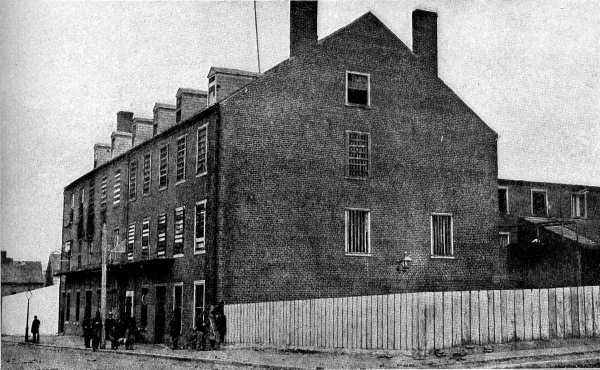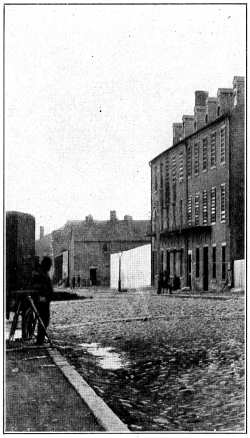|

Castle Thunder in Richmond—the Chief Provost Prison in the South
This ancient
tobacco-factory, with the platform for drying the leaf suspended in front,
and the bedding hanging from an unbarred window, looked far from war-like as
its picture was taken in 1865. Aside from the soldiers, there is no
indication that this was the penitentiary of the Confederacy. In it were
confined Confederates under sentence of military court, deserters, and only
rarely Union soldiers. The commander, Captain G. W. Alexander, was a
disabled soldier, a man of great vigor and determination. He enforced
discipline, but his motley crew sometimes required vigorous measures. The
management of the prison was investigated in 1863 by a committee of the
Confederate Congress. The majority of the committee acquitted Captain
Alexander, though two minority reports were submitted. The most difficult
prisoners with whom he had to deal were said to be "plug-uglies," of
Baltimore and the "wharf-rats" of New Orleans. Among his charges were many
who thought nothing of murdering.
Arbitrary arrests were
less frequent in the South than in the North. President Davis did not assume
the right to suspend the writ of habeas corpus, and this privilege
was grudgingly granted him by the Confederate Congress for only limited
periods. The larger number of arrests were made at first under what was
known as the "Alien Enemies Act," approved by the President August 8, 1861.
On August 30th a commission was appointed on the suggestion of General J. H.
Winder, who wrote to the Secretary of War that he believed that many of the
prisoners who had been arrested should be discharged. A general jail
delivery followed. The jealousy of arbitrary power common to the Southerner
was shown by the attitude of the Confederate Congress, the Governors, and
Legislatures, who viewed with alarm any curtailment of the power of the
courts. Military officers were instructed to obey the writ of habeas
corpus and, if the judge ordered the discharge of the prisoner, to obey.
Afterward, they might then appeal to the Confederate district judge.

Photographer and Prison |
